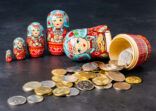The number of offshore fund offerings and facilitating agents stagnated in Taiwan, according to data by the Securities Investment Trust & Consulting Association in Taiwan (Sitca).
Although the number of master agents varied, it is slightly less (42) from the peak of 45 three years ago.
Number of master agents and offshore asset managers over three years
Source: Securities Investment Trust and Consulting Association (Sitca).
The number of offshore funds offered grew slightly to 1049 from 1022 over the same period.
All offshore funds in Taiwan have to be registered with Financial Supervisory Commission in Taiwan before being available for sale. Typically they are distributed through a master agent, who puts the product in a local wrapper and offers it for sale to domestic investors.
Among the offshore funds available, Taiwanese investors have an increasing interest in emerging market funds. Emerging market funds accounted for 13% of marketshare year-to-September versus 11% for developed market funds.
Hybrid market funds, products investing in both developed and emerging markets, are the dominate category, with around NT 1170bn ($38.68bn) in assets.
In the category of single country funds, US allocation is the most popular, with about NT596.74bn ($19.7bn) in assets. Meanwhile, investor interest in Korea and Thailand funds declined this year, both with a 30% drop in assets.
Taiwan’s offshore funds by investment destination (in NT$bn)
| Sep-17 | Jan-17 | Market share | Change | |
| Global funds | ||||
| Developed markets | 375.30 | 379.7 | 11% | -1.16% |
| Emerging markets | 441.37 | 269.7 | 13% | 63.65% |
| Hybrid markets | 1169.72 | 1089.9 | 34% | 7.32% |
| Global Subtotal | 1986.39 | 1739.4 | 58% | 14.20% |
| Single Country funds | ||||
| Japan | 38.41 | 37.3 | 1% | 2.97% |
| Korea | 3.91 | 5.7 | 0% | -31.40% |
| Thailand | 3.91 | 6.3 | 0% | -37.98% |
| Indonesia | 6.44 | 6.5 | 0% | -0.88% |
| India | 39.93 | 45.1 | 1% | -11.47% |
| US | 596.74 | 500.8 | 17% | 19.16% |
| United Kingdom | 0.76 | 0.6 | 0% | 27.04% |
| Australia | 3.71 | 4 | 0% | -7.34% |
| Russia | 21.19 | 21.7 | 1% | -2.35% |
| Other | 13.25 | 14.8 | 0% | -10.50% |
| Single Country Subtotal | 730.13 | 643 | 21% | 13.55% |
| Regional funds | ||||
| North America | 71.62 | 74 | 2% | -3.21% |
| Developed Europe | 145.69 | 138.1 | 4% | 5.49% |
| Asia Pacific(Exclude Japan) | 236.58 | 231.9 | 7% | 2.02% |
| Asia Pacific(Include Japan) | 33.35 | 32.9 | 1% | 1.38% |
| New Zealand & Australia | 0.27 | 0.4 | 0% | -33.28% |
| Emerging Europe | 40.85 | 42.1 | 1% | -2.98% |
| Emerging Latin America | 73.56 | 70.2 | 2% | 4.79% |
| Other emerging markets | 5.33 | 4.8 | 0% | 10.96% |
| Mainland China & Hong Kong | 101.63 | 100.8 | 3% | 0.82% |
| Others | 13.63 | 12.1 | 0% | 12.60% |
| Regional Subtotal | 722.50 | 707.3 | 21% | 2.15% |
| TOTAL | 3,439.02 | 3,089.60 | 100% |
11.31% |
Source: Securities Investment Trust and Consulting Association . Categories include both equity and fixed income funds
In terms of asset classes, fixed income funds continue to top the chart. In September, they represented half of total offshore assets. Taiwanese invest mainly in high yield bond funds. However, emerging market bonds became more popular this year, with a year-to-September leap of 78.9%, data by Sitca shows.
Offshore funds by asset class (in NTbn)
| Sep-17 | Jan-17 | Market share | Change | |
| Equity Fund | 1,258.2 | 1,213.9 | 36.6% | 3.6% |
| Bond fund | 71.3 | 70.8 | 2.1% | 0.6% |
| High yield bond fund | 997.0 | 960.2 | 29.0% | 3.8% |
| Emerging market bond fund | 363.4 | 203.1 | 10.6% | 78.9% |
| Others | 305.3 | 285.0 | 8.9% | 7.1% |
| Fixed income fund Subtotal | 1,736.9 | 1,519.0 | 50.5% | 14.3% |
| Balance fund | 408.7 | 321.2 | 11.9% | 27.2% |
| Money market fund | 31.4 | 31.6 | 0.9% | -0.6% |
| Fund of funds | 0.0 | 0.0 | 0.0% | 0.0% |
| Exchange traded fund | 0.3 | 0.2 | 0.0% | 30.9% |
| Others | 3.6 | 3.6 | 0.1% | -1.1% |
| Total | 3,439.0 | 3,089.6 | 100.0% | 11.3% |
Source: Securities Investment Trust and Consulting Association . Categories include both equity and fixed income funds
On domestic side, the overall AUM of 790 onshore funds in Taiwan grew 7.5% year-to-date, mainly due to capital flowing into ETF products, data by Sitca shows.


















